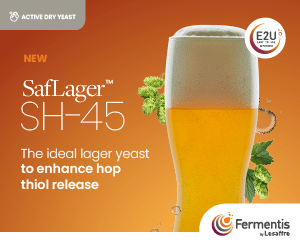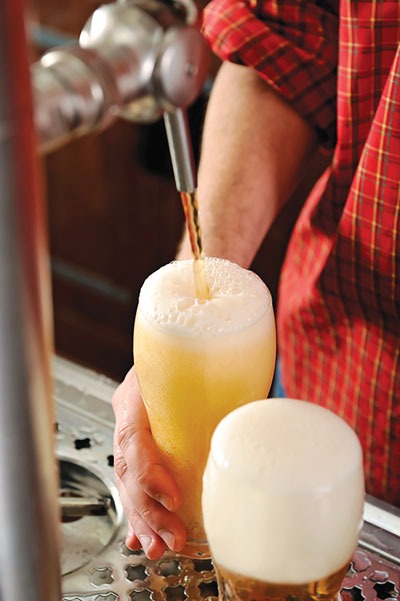Using Nitrogen: Tips from the Pros
Brewer: Bill Tressler
Brewery: Green Bay Brewing Co.
Years of experience: 4 years homebrewing, 4 years professional
Education: American Brewer’s Guild apprenticeship program; University of Calif., Davis, practical brewing course
House Beers: Hinterland Pale Ale, Amber, Honey Wheat, Packerland Pils, Pub Draught, and Maple Bock
Bill Tressler should have known what he was getting into when he and his wife, Michelle, decided to start the Green Bay Brewing Co. He was editor of two beer-related magazines, which gave him more perspective than most in the heady days of 1995, when officially 287 breweries and brewpubs opened and only 27 closed.
The numbers aren’t nearly that rosy today. The Institute for Brewing Studies reported that in the first half of 1998, just 57 microbreweries and brewpubs opened, and 52 closed. While overall craft beer sales increased more than 50 percent in 1994 and again in 1995, total growth was in single digits in 1997. Tressler looks at the figures through veteran eyes, even though Green Bay Brewing celebrated just its third anniversary in October.
“It’s nice to see the industry getting back to where we were initially headed,” he says, talking about the beauty of beer as a fresh, local product. “We all saw the opportunity to go into multiple states.” In fact you will find Green Bay’s Hinterland beers in Chicago and Minneapolis, but those markets account for little of the brewery’s sales.
The brewery is moving to cement its Green Bay connection by moving from Denmark, a small town south of Green Bay, into the city to a building close to Titletown Brewing Co., a brewpub.
“We were pretty much out of room,” Tressler says, explaining why the brewery is moving, probably in February or March. “Plus, we always felt we were a little out of sight, out of mind.”
The brewery is located in a previously unused portion of a cheese factory. The Tresslers started with a seven-barrel Criveller brewhouse but ordered a 30-barrel system by the time the brewery was six months old. “We said, ‘Let’s invest on the equipment side,’” Tressler says. He knew the labor-saving costs of brewing in larger batches would help pay for the system over time. “At the time it was just Michelle and I, so for me it was a big relief.” Since, Joe Karls was hired to help with brewing.
The key equipment acquisition, though, was the bottling line. “We didn’t have any consistency,” Tressler says. The volume of CO2 in bottles varied significantly from one run to the next, before Green Bay bought a used Meier filler from Old Raleigh Brewing in Raleigh, N.C. The converted 40-valve filler (Tressler pulled every other valve to make it a 20-valve filler) turns out 60 bottles a minute, all with the same volume of CO2.
“When you are buying used equipment, you really have to be careful,” Tressler says. He hired a former Pabst Brewing Co. employee as a consultant in buying the bottling line. “He does work for breweries like Stevens Point and Boston Beer. It cost us some money, but it was worth it,” Tressler says.
Although Tressler grew up in Green Bay, he and Michelle had been gone for seven years when they returned to start the brewery. “It’s a different culture around here,” Tressler says. “You get used to the great things about a big city (San Francisco).”
The Tresslers plan to introduce some of those things when the new brewery opens. “Michelle and I would like to bring some of the specialty items we’ve found into the retail store,” Tressler says. In addition to having a store, the new brewery will offer beer for sale by the glass. “There’s a great space for a beer garden,” Tressler says. “Most of all, we want it to be a really comfortable place.” It will also have a full kitchen, so while food won’t be served regularly, the brewery can host beer dinners and offer food demonstrations.
Tressler also found Green Bay was far different than the San Francisco Bay Area when it came to beer. “I think it has come a long way,” he says, but when he first rolled out Hinterland Pale Ale, he saw a lot of puckered faces. “I couldn’t give it away,” he says. It had a relatively tame 22 International Bittering Units, a third less than you’d likely find in a West Coast pale ale. “People would say, ‘This is way too bitter.’”
Hinterland Pale Ale and Hinterland Amber are the brewery’s flagship beers. “It varies from market to market,” Tressler says. “In Madison we sell more pale ale. Here, it’s more amber.”
Tressler has a good feel for what sells, because Green Bay has moved to self-distributing its beers outside of Green Bay (except in the farthest markets, such as Chicago). He found that many distributors wanted the brewery to keep offering specials and cutting the price of the beer, and it became hard to justify shipping them beer.
The day after splitting with one distributor, Tressler bought a van (he traded beer for the brewery’s first delivery truck) and “I’m down there.” Quite often, he discovered old beer when he visited accounts.
“You pull out old product, put in new, and your sales go up immediately,” he says. “People are happy to see me; I get to know the customers. You’ve got fresh beer out there all the time, and when there’s a problem, you know it.”
All the Green Bay beers are produced under the Hinterland label. Along with the Pale Ale and Amber, Honey Wheat, Packerland Pils, Pub Draught, and a non-traditional Maple Bock are brewed year-round. Seasonals are a traditional weizen and Winterland, an “evolving style” that gets a little more stoutish every year and always includes juniper berries.
The Pub Draught, a nitrogen-driven beer along the lines of Pyramid DPA, is a new product. “We started out saying we wanted to do a nitrogen beer,” Tressler says. Since Greene King Abbot Ale is one of his favorite beers, the rest was pretty easy. The English-style pale ale is fermented with English yeast and hopped with East Kent Goldings. The challenge, of course, is conditioning it with nitrogen.
Nitrogen Tips
Guinness Stout is king of the nitrogen pour in the United States, but the “nitrokeg” ales that were introduced in England in the early 1990s have begun to make their way across the Atlantic. Some microbreweries, most notably Pyramid with its DPA, and even a few brewpubs have experimented with conditioning with nitrogen and serving with a combination of nitrogen and C02.
The Campaign for Real Ale (CAMRA) in Britain has fought vigorously against nitrokeg beers because they take market share away from “real ale.” They are easier to care for than real ale, yet because nitrogen bubbles are much finer than C02 bubbles, nitro beers seem creamier and less filling. With the rollout of Caffreys Irish Ale in November, the Guinness Imports Co. has guaranteed that nitrokeg beers will soon be better known in the United States. They certainly are a sensible alternative to trying to serve a five-gallon batch of homebrewed real ale before it begins to oxidize (about three days).
“You’d have to be a pretty sophisticated homebrewer,” Tressler says, to emulate the process and properly dispense the beer. However, Green Bay doesn’t have the expensive equipment Pyramid and Guinness use, and it is doable at home.
“It takes about five days to dissolve the nitrogen into the beer,” Tressler says. The beer must be kept really cold because nitrogen does not dissolve into beer nearly as easily as C02. That’s also the reason that nitrogen must be introduced under pressure. “It should be 15 to 20 pounds of pressure; 20 is better, and I’m not sure if a Cornelius keg can handle that.”
You should look ahead to how you are going to serve the beer before you start conditioning. Some bars use both nitrogen and C02 tanks to serve Guinness, but rather than spend money on a mixing device, most buy a pre-mixed gas (80 percent nitrogen and 20 percent C02) referred to as “G-mix.” Homebrewers can use that same mix and a Guinness-type spout but not for conditioning.
“It’s got to be straight nitrogen,” Tressler says. He gives the nitrogen about a day to dissolve, then lets the beer breathe and introduces more nitrogen.
“You keep going back and forth,” he says. “Measurement is very difficult. It’s mostly sight and taste. Over the period of five days, we keep testing it. Each batch, there is a little difference,” he says.
Tips for Using Maple in Beer
Green Bay started selling Maple Bock about the same time several other breweries rolled out maple beers that tasted distinctly of maple.
“It’s been a challenge to introduce,” Tressler says. “People said, ‘Oh, my god, I don’t want another maple beer.’ We’re already seeing those beers disappear. This is one beer, I think, that can outlast the gimmicks.”
The last thing he wants is a maple-tasting beer, something that reminds drinkers of pancakes and the gooey concoctions that grocery stores sell as syrup. The Tresslers know the maple syrup in Maple Bock is pure because they make it themselves. “It’s much like homebrewing,” Tressler says. “I’ve been doing it for 20-some years. For me it was part of growing up, something my parents did to get us out of the house near the end of winter.”
It takes 40 gallons of sap cooked over a wood fire to make one gallon of syrup. The Tresslers get their sap from sugar maples on Bill’s parents’ property. “We spend three weeks some years vs. six others. It varies from year to year on the syrup; it’s not scientific,” he says. “If (homebrewers) have sugar maples near, they should try it. It’s a lot of fun.”
“The idea is not to have the maple flavor,” Tressler says. “Essentially we want the maple as an extra fermentable sugar and the hint of roasting (from cooking the sap over wood) that melds with the beer.” He figures the maple syrup raises the original gravity of the wort one degree Plato and adds about 1 percent alcohol by volume to the finished beer.
When the beer was reviewed in All About Beer magazine, Charlie Papazian wrote, “Perhaps there is maple in this beer, but I can’t perceive any in flavor or aroma.” He did, however, find a bit of smokiness. Tressler was delighted on all counts.
Tressler uses several malts in the beer, including Munich, chocolate, and Schreier Special B (“my favorite malt of all time”). The maple syrup is added near the end of the boil, but much of the maple will still boil off. “As soon as it dissolves, we start the whirlpool,” Tressler says.
The bock ferments with ale yeast rather than lager yeast. “We keep it at 50° to 56° F, so we don’t get lots of estery characteristics. Then on the backside we lager it for about 30 days,” Tressler says.
The beer finishes with about 6.5 percent alcohol by volume and is perfect for sitting outside by a wood fire and making the next batch of maple syrup.
_____
The Tips:
• Allow your nitrogen-dissolved beers to sit under pressure longer than your CO2 beers.
• Purchase a pre-mixed gas (80 percent nitrogen, 20 percent CO2) to serve your nitrogenated beers.
• While dissolving the nitrogen, switch back and forth between air and nitrogen.







